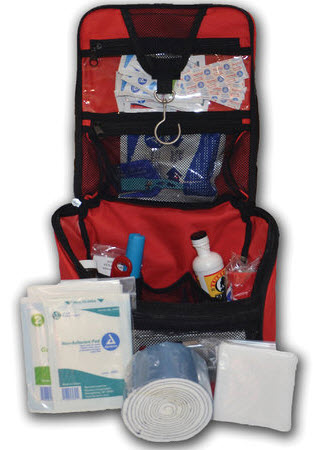First Aid Horse Essentials

Being prepared to immediately give your horse first aid in the event of an illness or injury might make a big difference in the outcome of the situation. It’s wise to be prepared in case something happens, and an equine first-aid kit helps to ensure that you can care for your horse while waiting for an equine veterinarian to arrive. Start creating a basic first-aid kit with these helpful items.
Equine First-Aid Kit Basics
- Flashlight. During the early morning hours, as sunset approaches or even in dark, tree-covered areas, a flashlight can be useful when assessing the problem.
- Thermometer. Having a thermometer on hand lets you determine if your horse has a normal temperature. Typically this is between 99 and 101.5 Fahrenheit, but taking your horse’s temperature regularly when he is healthy will help determine what is normal for your particular horse.
- Stethoscope. A horse’s heartbeat can be heard loudest behind its left elbow. A stethoscope also comes in handy for listening to the gut.
- Antibiotic ointment. Superficial wounds and scrapes can be treated with antibiotic ointment to help prevent infection.
- Diluted iodine. Any cuts, scrapes or puncture wounds can be flushed out with diluted iodine and covered to keep them from drying until the vet comes to treat them.
- Electrolytes. Help protect your horse from dehydration and lethargy by carrying a powder or paste form of electrolytes in your first-aid kit.
- Scissors or knife. It’s important to have something for cutting bandaging material, or for freeing a horse caught in a rope or other entanglement. Always exercise caution when using scissors around your horse.
- Bandaging materials. A variety of bandaging materials are good to have on hand. Include some of the following in your first aid kit: nonstick gauze and cotton padding, duct tape and disposable diapers, sterile gauze and elastoplast, white adhesive medical tape, plastic wrap and cotton leg wraps.
- Fly repellant. Keep pesty flies away from an open wound that can’t be covered with a bandage by applying fly repellant around the wound, but not directly on it.
- Cooling packs. Ice packs that become cold when you bend or twist them could be useful when cold therapy is recommended by the equine veterinarian.
When First Aid is Needed
Before you consider administering any type of first aid to your horse, there are several things to consider. Start by calming yourself; your horse might already be scared and excited, and being in a panic yourself will only exacerbate the situation. Collect your thoughts and proceed by caring for your horse in a calm, slow manner. At that time, you should assess your horse’s attitude and behavior. If you’re not 100 percent sure that it’s OK to approach him safely and check the injury or problem, then wait until professional help arrives. Should you be able to safely approach your horse, it can be helpful to talk to him quietly and gently rub his neck for reassurance. Move the horse to a quiet location, if possible.
Once you have your horse secure, call your veterinarian so they can assess the injury or illness. Having a first-aid kit on hand allows you to administer initial care to your horse if needed while waiting for the vet. In addition to having a first-aid kit in the barn, it’s also helpful to have a travel kit that you can bring with you each time you take your horse off your property. While the list above can serve as a base to help you get started as you put together an effective kit, always make sure that you consult your veterinarian on what other items will complete your first-aid kit so you are never left stranded.
Ashly Snell works at Dover Saddlery and has been an avid equestrian for 20 years. She currently enjoys eventing with and caring for her two Dutch Warmbloods. First Aid Kit Photo Credit: Dover Saddlery (www.DoverSaddlery.com)
